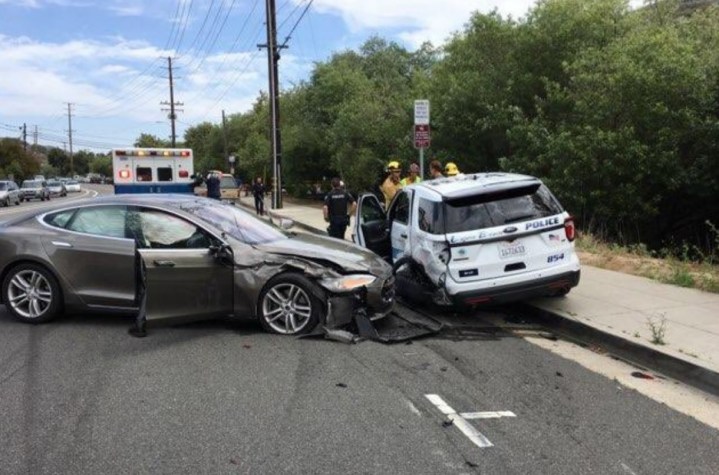
Police in Laguna Beach, California, say a Tesla Model S crashed into a parked patrol car. The driver, who suffered minor injuries, told investigators Autopilot was engaged at the time of the accident.
Local news channel ABC7 reports the incident happened on the morning of May 29 on Laguna Canyon Road. Though the investigation is ongoing, the first police officers who arrived at the scene noted the force of the impact pushed the Ford Explorer over the sidewalk. Both cars sustained a substantial amount of damage; police declared the patrol car a total loss. Luckily, it was unoccupied at the time of the impact.
We don’t know exactly what happened or how fast the Tesla was driving. The investigation will reveal whether Autopilot malfunctioned, or if this represents yet another case of technology-aided distracted driving. Police sergeant Jim Cota noted the crash happened in the same spot a Tesla collided with a semi last year.
“Why do these vehicles keep doing that? We’re just lucky people aren’t getting injured,” Cota told the Los Angeles Times.
This morning a Tesla sedan driving outbound Laguna Canyon Road in “autopilot” collides with a parked @LagunaBeachPD unit. Officer was not in the unit at the time of the crash and minor injuries were sustained to the Tesla driver. #lagunabeach #police #tesla pic.twitter.com/7sAs8VgVQ3
— Laguna Beach PD PIO (@LBPD_PIO_45) May 29, 2018
Tesla hasn’t commented on the cause of the crash. We imagine that will soon change. Company co-founder and CEO Elon Musk recently criticized members of the media for covering accidents involving Tesla’s vehicles. Speaking during a conference call, he explained he’s tired of the bad press and pledged to release quarterly safety reports to persuade drivers and journalists that the system makes driving safer, not more dangerous. The company nonetheless acknowledges some drivers use Autopilot improperly on a regular basis.
“When using Autopilot, drivers are continuously reminded of their responsibility to keep their hands on the wheel and maintain control of the vehicle at all times. Tesla has always been clear that Autopilot doesn’t make the car impervious to all accidents, and before a driver can use Autopilot, they must accept a dialogue box which states that ‘Autopilot is designed for use on highways that have a center divider and clear lane markings,'” a Tesla spokesperson told Digital Trends.
The accident is the latest in a surprisingly long string of Autopilot-related crashes this year. Earlier in May, a 28-year old woman suffered a broken ankle when her Tesla Model S slammed into the back of a fire truck parked at a light on the outskirts of Salt Lake City. Reviewing the vehicle’s logs revealed she had Autopilot turned on but used the system improperly because she regularly took her hands off the steering wheel. She admitted she was looking at her phone before the impact.
In March, the 38-year old driver of a Model X died after his crossover drove into a concrete divider on Highway 101 in Mountain View, California. He had engaged Autopilot, but he took his hands off the steering wheel moments before the collision. In January, another Model S rear-ended a fire engine at 65 mph in Culver City, California. The driver blamed Autopilot; the investigation into the crash remains open.
Update: added statement from Tesla.



